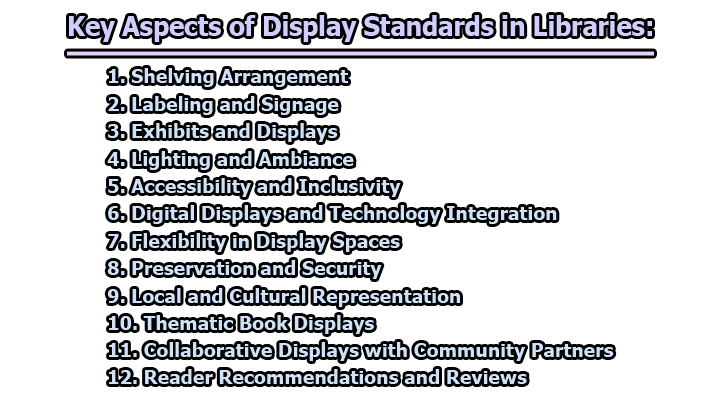Key Aspects of Display Standards in Libraries:
Libraries serve as vital hubs of knowledge, providing a quiet sanctuary for study and a resource-rich environment for learning. Display standards within libraries play a crucial role in creating an engaging and user-friendly atmosphere. These standards encompass various elements that contribute to the organization, accessibility, and aesthetic appeal of library spaces. In this exploration, we will delve into the key aspects of display standards in libraries.
1. Shelving Arrangement: Shelving arrangement is a foundational element of display standards in libraries, directly impacting user experience and accessibility. The selection of a classification system, such as the Dewey Decimal Classification or Library of Congress Classification System, plays a crucial role in organizing and categorizing books systematically. The arrangement should be intuitive, allowing patrons to locate materials easily based on subject matter, genre, or author.
A well-thought-out shelving arrangement optimizes space utilization, ensuring that the library can accommodate its collection effectively. Additionally, consideration should be given to factors such as shelving height and accessibility for all patrons, including those with mobility challenges. Libraries may also implement special sections, such as children’s or reference sections, with tailored shelving arrangements to cater to specific user needs.
Effective shelving practices also involve regular maintenance and periodic reorganization to accommodate new acquisitions and changing user preferences. This adaptability ensures that the library’s collection remains dynamic and relevant, contributing to a positive and user-friendly environment.
2. Labeling and Signage: Clear and informative labeling is essential for facilitating smooth navigation within the library. Consistency in labeling across book spines, shelves, and aisle markers is crucial for helping patrons locate specific materials. The font size, style, and color should be carefully chosen to ensure readability, particularly for patrons with visual impairments.
Signage is a vital component of guiding patrons through different sections of the library. Well-designed signage should not only be informative but also visually appealing. It should include directional signs leading to key areas such as fiction, non-fiction, restrooms, and study spaces. Digital signage can be employed for dynamic updates, event notifications, and emergency information.
Libraries should also consider multilingual and universally recognizable symbols in their signage to cater to diverse user demographics. Regular assessment and updates of signage are necessary to address changing needs and maintain clarity in the library’s layout.
3. Exhibits and Displays: Libraries are not static repositories; they are dynamic spaces that can engage patrons through carefully curated exhibits and displays. Themed exhibits, whether showcasing new acquisitions, celebrating literary milestones, or highlighting local history, capture the attention of visitors and create a visually stimulating environment.
Interactive displays, multimedia elements, and hands-on exhibits enhance user engagement, especially for younger audiences. These displays can be rotated regularly to maintain a sense of novelty and curiosity, encouraging repeat visits from library patrons.
Strategic placement of exhibits near high-traffic areas and entrances ensures maximum visibility. Collaborations with local artists, authors, or organizations can further enrich the content of displays, fostering a sense of community involvement and pride.
4. Lighting and Ambiance: The importance of lighting in libraries cannot be overstated. Adequate lighting is essential for creating a comfortable reading and study environment. Natural light is preferred where possible, as it not only provides an inviting atmosphere but also reduces the strain on patrons’ eyes.
Careful consideration of color temperature, with a focus on warmer tones, contributes to a cozy and inviting ambiance. Task lighting in study areas and ambient lighting in communal spaces should be balanced to cater to different user needs. Lighting fixtures should be regularly maintained to prevent glare or flickering, ensuring a conducive atmosphere for reading and research.
Libraries may explore energy-efficient lighting solutions to align with sustainability goals while maintaining a well-lit and welcoming environment. A combination of natural and artificial lighting sources allows for flexibility in adapting to different lighting conditions throughout the day.
5. Accessibility and Inclusivity: Display standards should prioritize accessibility and inclusivity to ensure that library spaces are welcoming to patrons with diverse needs. Shelving heights should be adjusted to accommodate patrons of varying heights, including those using mobility aids. Clear pathways and adequate space between shelves are essential for wheelchair accessibility.
Inclusive design principles should guide the selection of furniture and fixtures, considering the comfort and accessibility of all patrons. Tactile signage and Braille labels contribute to a more inclusive environment for patrons with visual impairments. Furthermore, digital accessibility measures, such as providing online catalogs and resources, enhance the overall accessibility of library services.
Regular training for library staff on assisting patrons with diverse needs fosters a culture of inclusivity. Surveys and feedback mechanisms can be employed to gather input from patrons, ensuring that the library remains responsive to the evolving needs of its community.
6. Digital Displays and Technology Integration: In the digital age, libraries can enhance their display standards by integrating technology. Digital displays, interactive kiosks, and touchscreens provide opportunities for real-time information dissemination. Libraries can use these displays to showcase upcoming events, feature recommended reads, or offer virtual tours of special collections.
Digital signage allows for dynamic content updates, ensuring that patrons are informed about the latest additions to the collection, ongoing exhibits, and community events. These displays can be strategically placed in high-traffic areas to maximize visibility and engagement.
Technology integration extends beyond displays to include online catalogs, e-books, and interactive learning platforms. A seamless integration of digital resources with physical displays enhances the overall user experience, catering to the preferences and expectations of patrons in the digital era. Regular maintenance and updates of digital displays are essential to ensure their functionality and relevance.
7. Flexibility in Display Spaces: Flexibility is a key consideration in modern library design, and this extends to display spaces. Library layouts should incorporate modular furniture, movable displays, and reconfigurable spaces. This adaptability allows libraries to host a variety of events, exhibitions, or collaborative activities, catering to the diverse needs and preferences of their users.
Movable shelving units enable libraries to transform spaces for different purposes, such as hosting author talks, book clubs, or community workshops. Flexibility in display spaces also accommodates changes in the library’s collection, ensuring that new acquisitions or thematic displays can be seamlessly integrated.
By fostering an environment where spaces can be easily adapted, libraries remain versatile and responsive to the evolving interests and requirements of their community. This flexibility enhances the library’s role as a dynamic community hub.
8. Preservation and Security: Preservation and security are paramount considerations when displaying valuable or delicate materials in libraries. The environmental conditions, including temperature and humidity, should be carefully controlled to prevent deterioration of rare books, manuscripts, or artifacts on display. Protective cases with controlled climate features may be necessary for particularly sensitive items.
Security measures, including surveillance systems and alarm systems, are essential to safeguard against theft or damage. Display areas should be strategically located and monitored to discourage unauthorized handling or removal of items. Library staff training in preservation techniques and emergency response protocols ensures a proactive approach to protecting the integrity of displayed materials.
Balancing accessibility with preservation requires thoughtful curation and risk assessment. By implementing proper preservation and security measures, libraries can continue to share their valuable collections with the public while ensuring their long-term sustainability.
9. Local and Cultural Representation: Libraries serve as community anchors, and their displays should reflect the local culture and history. Incorporating exhibits and displays that celebrate the unique aspects of the community fosters a sense of pride and connection among patrons.
Local history displays, cultural exhibits, and collaborations with community artists contribute to a rich and vibrant library experience. Engaging with local schools, historical societies, or cultural organizations allows libraries to tap into the wealth of knowledge and creativity within their community, creating displays that resonate with patrons on a personal level.
By showcasing the diversity and richness of the local culture, libraries become not only repositories of information but also active contributors to the cultural identity of the community they serve.
10. Thematic Book Displays: Thematic book displays are an effective way to engage patrons and encourage exploration of different genres or subjects. By organizing books based on themes, libraries can pique interest and promote diverse reading habits. Thematic displays can be aligned with seasons, holidays, or current events, creating a dynamic and ever-changing environment.
Libraries can feature staff recommendations, reader reviews, or curated lists to accompany thematic displays, providing additional context and guidance for patrons. These displays not only draw attention to specific genres or authors but also encourage serendipitous discoveries, as patrons may come across books they might not have otherwise considered.
Regularly updating thematic displays ensures that the library remains current and responsive to the evolving interests of its patrons. These displays contribute to a vibrant and engaging atmosphere, inviting users to explore new literary avenues.
11. Collaborative Displays with Community Partners: Collaborative displays with local businesses, schools, or organizations strengthen the library’s ties with the community. By featuring collaborative exhibits, libraries can showcase the talents and contributions of various community members, fostering a sense of shared ownership and pride.
Partnerships with local artists, authors, or historians can result in displays that offer unique insights and perspectives. Collaborative displays may include artworks, educational materials, or artifacts contributed by community partners, creating a dynamic and diverse library environment.
These displays not only enrich the library experience but also serve as a platform for cross-community collaboration, demonstrating the library’s role as a cultural and intellectual hub within the broader community.
12. Reader Recommendations and Reviews: Encouraging reader engagement is a valuable aspect of display standards in libraries. Implementing displays featuring reader recommendations and reviews adds a personal touch to the library experience, creating a sense of community among patrons. This display approach allows library users to share their thoughts on favorite books, creating a positive feedback loop that benefits the entire community.
Dedicated spaces for user-generated content, whether physical or digital, provide patrons with a platform to share their reading experiences. This can include handwritten recommendations, book reviews, or even interactive displays where patrons can leave comments or suggestions.
Reader-generated content fosters a sense of community participation and reinforces the idea that the library is a shared space where individuals can connect through their love of literature. Regularly updating these displays maintains their relevance and keeps the library’s atmosphere dynamic and responsive to the preferences of its users.
In conclusion, the key aspects of display standards in libraries extend beyond mere organization and functionality. Libraries are dynamic spaces that evolve with the needs and expectations of their users. By carefully considering elements such as shelving arrangement, labeling, exhibits, and technology integration, libraries can create vibrant and inclusive environments that foster learning, exploration, and community engagement. As libraries continue to adapt to the digital age, the role of effective display standards becomes even more essential in ensuring above spaces remain relevant, inviting, and indispensable to the communities they serve.

Library Lecturer at Nurul Amin Degree College










